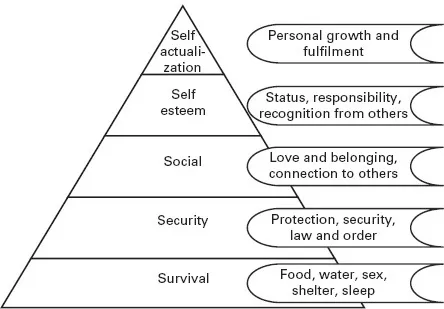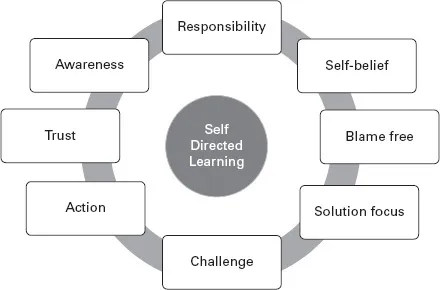![]()
PART ONE
The fundamentals of performance coaching
Introduction
Coaching is a relatively new profession yet arguably as old as human communication itself. Socrates is sometimes said to be the first coach, because many of the quotes attributed to him display a coaching approach of asking questions instead of giving instructions, for example: ‘I cannot teach anybody anything; I can only make them think.’
So how did the skills that we now term ‘coaching’, which are widely used in management training in organizations across the world, become recognized as an effective method of communication? How does it differ from sports coaching or teaching, the more well-known applications of the word? How did the coaching we teach to managers to motivate their staff become known as ‘performance coaching’?
My first chapter explores the broad range of trends, professions and academic disciplines from which the framework of performance coaching has been extracted.
![]()
SUMMARY
• Origins of the term ‘coaching’
• The principles of coaching
• Types of coaching
Origins of the term ‘coaching’
In the free Western world of the 1950s, a post-war zeitgeist embraced a new sense of optimism, self-responsibility and focus on the future. Over the next three decades, these trends showed up in psychology, business, sport, culture, politics and parenting.
The twentieth century saw rapid developments in the field of psychology. Until the 1940s, psychology focused on identifying problems and fixing what was wrong, notably through the work of Freud and Jung. A major shift then occurred through the work of psychologists such as Abraham Maslow and Fritz Perlz.
Maslow’s widely publicized ‘hierarchy of needs’ (1968), shown on the next page, depicted the stages through which people have to pass in order to reach what Maslow called ‘self-actualization’, meaning the fulfilment of the best that a person could be in terms of his or her own unique potential (Maslow, 1998).
Maslow chose to study exemplary people such as Albert Einstein rather than mentally ill or neurotic people, writing that: ‘The study of crippled, stunted, immature, and unhealthy specimens can yield only a cripple psychology and a cripple philosophy.’
The difference between this approach and what went before is that Maslow looked at what was right about human beings rather than what was wrong. In this lies one of the key principles of coaching: focus on the solution, not the problem.
Maslow’s hierarchy of needs
Perls’ Gestalt therapy (1951) focused on creating awareness in people. Its principles were:
‘Live now, stay in the present
Live here, be with the present
Stop imagining, experience reality
Stop unnecessary thinking
Express, rather than manipulating, explaining, justifying, or judging
Give in to unpleasantness; do not restrict your awareness
Accept no ‘should’ or ‘ought’ other than your own
Take full responsibility for your own actions, feelings and thoughts
Surrender to being who you are right now.’
Therein lie the two principles of ‘awareness’ and ‘responsibility’, later identified by Sir John Whitmore as the essence of good coaching (Whitmore, 2009).
During the 1980s, solution focused brief therapy (SFBT) (Shazer, 1988) was developed through the collaboration of a number of psychologists including Steve de Shazer and Milton Erickson. As its name infers, SFBT encouraged people to look to the future and take action, rather than analyzing and therefore remaining limited by the past. SFBT’s methodology is illustrated by its ‘miracle question’, of which there exist many variations:
‘Suppose our meeting is over, you go home, do whatever you planned to do for the rest of the day. And then, sometime in the evening, you get tired and go to sleep. And in the middle of the night, when you are fast asleep, a miracle happens and all the problems that brought you here today are solved just like that. But since the miracle happened overnight nobody is telling you that the miracle happened. When you wake up the next morning, how are you going to start discovering that the miracle happened? … What else are you going to notice? … What else?’
At the same time as these later developments in psychology, there were extraordinary changes taking place in the field of commerce. Ricardo Semler, for example, turned control of his multi-national organization Semco over to its employees, even allowing people to set their own salaries (Semler, 2001). Andy Law practised a similar style of management when he formed St Luke’s Advertising Agency (Law, 1999).
In education, responsibility for learning started to be handed over to the pupils, sometimes at the expense of a formal curriculum.
Meanwhile, whole new areas of personal self-development emerged, encouraging people to create their own solutions for their physical, mental and spiritual health. This trend occurred both in the field of fitness, with the proliferation of gyms and the spread of practices such as yoga, Tai Chi and aerobics, and in personal wellbeing, which spawned a multitude of books starting with Dale Carnegie’s 1956 best-seller, How to Win Friends and Influence People, and including Zen and the Art of Motorcycle Maintenance, The Female Eunuch, The Games that People Play, Men are from Mars, Women are from Venus and numerous guides on how to be happy, including one by the Dalai Lama.
The principles now identified as coaching (which are explored later in this chapter) were evident to some extent in many of these areas and have been particularly identified in the writings of psychologists, especially organizational, over the last 30 years. However, the only direct link between these principles and the word ‘coaching’ that I have been able to find came from the sports arena, and offers an answer to the question of why the term, with its inappropriate implication of instruction, has been applied at all.
Timothy Gallwey was a Harvard graduate of the 1970s who became captain of the tennis team while on sabbatical. Gallwey noticed that when he left the court, his students tended to improve their game more quickly than when he was there to instruct them. Already a disciple of spirituality and psychology, Gallwey explored this paradox and developed a series of questions, statements and exercises to support the self-teaching process. One of his key actions was to apply ‘directionality’ – identifying one’s goal before starting out (Gallwey, 1986).
During the 1980s, Gallwey’s work was embraced by English baronet, Sir John Whitmore, who in 1992 published Coaching for Performance, a book now regarded as the ‘bible’ of coaching and available in 19 languages. Whitmore, the son of a baronet, entered his twenties in the 1960s as a member of the elite British aristocracy and a racing driver who moved in international circles and counted Steve McQueen among his friends. Then he discovered the Esalen Institute in California and his life changed profoundly and acquired a deeper direction. Esalen was founded in 1962 as a series of encounter groups and an extraordinary number of influential thinkers, psychotherapists, spiritual leaders and writers became involved, including Fritz Perls, Carl Rogers, Abraham Maslow, Virginia Satir, Aldous Huxley, Timothy Leary, Arnold Toynbee, Deepak Chopra, RD Laing, Susan Sontag, Joan Baez and Ken Kesey (Wildflower, 2013). Whitmore is quoted as recently saying that Esalen was vital to the development of coaching: ‘That time and Esalen were crucial [to the coaching profession] and that is where, in a way, it all started’ (Wildflower, 2013).
Whitmore combined this personal development journey with Gallwey’s techniques and brought the package to Europe by founding schools for skiing and tennis that used the new approach of self-directed learning. At one point, his team was asked to provide a day of tennis coaching by a large organization that wanted its managers to incorporate the ‘Inner Game’ approach into their leadership styles. Whitmore termed this ‘performance coaching’ to differentiate it from conventional sports coaching, and gave his book a similar title.
And this, it seems, is how the term ‘coaching’, to which the fields of psychology, business and self-development have all contributed so much, originated.
The principles of coaching
There has been some confusion over the application of a word that conventionally means ‘instructing’ to an area whose guiding principle has been described as ‘self-directed learning’. The overall principles of coaching may be summed up as shown in the diagram below.
Awareness: Awareness of self and others is a key aspect of coaching and gives rise to many other benefits. The coach provides a space where clients can uncover knowledge that already lies within, but that may have been obscured by the turmoil of fear, confusion or limitations imposed by other people’s agendas.
The principles of coaching
Responsibility: A core principle of coaching is self-responsibility, or taking ownership of our decisions; most people enjoy creating their own solutions rather than being told what to do. In terms of leadership, this means treating people with respect and providing opportunities for development where possible.
Self-belief: There are two components involved in building confidence in people: firstly, allowing them the space to practise, stretch themselves and make mistakes; secondly, giving them recognition for their achievements.
Confidence that we can do something is a key factor in achieving it. Giving people praise buil...


